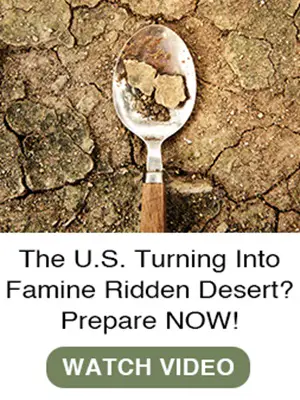Estimated reading time: 14 minutes
Most people don’t take the time to harvest rainwater. It seems like a hassle and it’s so easy to just get water from the kitchen sink from a well pump or municipal water supply. Unfortunately, there are some times and occasions when rainwater could not only save some money, but can provide access to water during a power outage.
It’s Not That Hard
There are some rainwater collection systems that can be set up in less than an hour. Even more ambitious setups would take no more than an afternoon or at worst a weekend. Some designs cost nothing to put together using found or available materials, but even when you invest in a rainwater collection system the total cost will be a couple of hundred dollars at most. More ambitious systems could cost more but that depends on the situation.
Benefits of Harvesting Rainwater

- It’s free. Rain water come with no cost and it’s even delivered. At a time when municipal water bills continue to increase, and even the availability of water is sometimes rationed or restricted, rainwater can be a steady source of water without the water bill.
- It’s a great emergency backup. A lot can happen to compromise our supply of water. A power outage immediately cuts off the water for people dependent on a well pump. Even municipal supplies that are gravity fed from a water tower can run out if an outage continues after the towers are drained. Municipal water towers depend on electric powered pumps for refilling and without electricity – pumps don’t work. Even a home plumbing problem can cut off your water for a day or two.
A lot of this assumes you live in an area with fairly consistent rainfall, but even someone living in a desert area or enduring a drought can harvest and collect rainwater and probably should. Dry areas are notorious for having water restrictions, and your ability to collect and store as much rainwater as you can when it does rain is probably a good idea.
Incorrect Assumptions About Harvesting Rainwater

We mentioned that rainwater is very pure but be careful. Most rainwater that is harvested is collected as runoff from a roof. Roofs have a tendency to collect a lot of pollutants. Bird droppings are the most obvious but even the dust, dirt and chemicals in the wind can and will adhere to roof shingles.

Adding to the mix of possible pollutants are the leaves and tree branches that fall to roofs and collect in gutters. Don’t assume your rainwater is automatically safe for drinking. Take the time to filter it and purify it. We’ll cover some easy solutions for doing this, but don’t assume that because it’s typically pure and looks clean that it’s safe to drink.
Another thing to keep in mind is any rain water that has been stored in a barrel or drum for any length of time. If your rainwater has been sitting in the barrel for weeks, it’s a good bet that some significant bacteria have had a chance to develop and grow. It’s fine for watering a garden or other outdoors uses, but that’s when you really need to think twice about filtering and purifying before using it for drinking or cooking.
Rainwater Harvesting Concepts

The fundamental concept of any rainwater collection system involves harvesting the runoff from a large angled surface exposed to sky, and channeling or funneling the runoff into a container to store the rainwater.
The size of the surface and the size of the container will determine how much rainwater you can harvest and store. Rooftops are often the first choice for serious rainwater harvesting, but remember than any roof will do. This include the roof of your home but also a detached garage, shed, barn, or greenhouse. If it has a roof you’ve one step closer to getting a good harvest of rainwater.
Here are some of the many options from the simplest to the most complex.
1. A Tarp in the Trees

Something as simple as a tarp suspended from 4 trees can present enough surface area to collect a decent amount of rainwater. A lot depends on the duration of the rain and its intensity, but a rap can work anywhere at anytime.
And it doesn’t have to be a tarp. I could be a sheet of plastic, a poncho, even a Mylar emergency blanket in the photo above. It’s a simple and fast way to collect rainwater in an emergency or on a camping trip.
2. A Tarp on the Ground

In an area without trees a tarp on the ground can catch and collect a lot of rainwater. A lot depends on the size of the tarp and the intensity of the rainfall, but if you support the corners and the sides above the ground to create a low area in the middle of the tarp you can collect a lot of rain in a large puddle. It’s not a long-term solution but it can catch a lot of rain in the short-term.
3. Rain Saucers

You can improvise large plastic cones over a water barrel to collect the water if you only have a patio or other small space. The cones expand the area for rain collection and over time can fill a barrel.
4. From Puddle to a Rain Collection Pond

If you want to create a long-term solution you can dig a large shallow hole and line it with a large pond-tarp to collect water. The size is up to you. The best location is a low lying area where the runoff on the ground will run towards and into your improvised collection pond.
You then scoop out the water as needed or use a battery powered water pump. Once again, the amount of water you collect and hold depends on the size of your shallow hole and the size of your tarp.
5. A Rain Collection Pond in the Garden

A permanent solution is a rain collection pond next to or in a garden. Once again, a low lying spot will deliver the runoff to the pond or you can direct rain into the pond from rooftop gutters or tarps channeling the rain into the pond.
6. From Pond to Pool

You can drink swimming pool water but anyone who has ever owned a pool knows how it eventually fills and even overflows from rainfall. There are pools that are easy to setup across a variety of sizes that let you easily collect rainwater especially if you direct rainfall into the pool with tarps around the perimeter or hoses from gutter downspouts.
7. Rooftop Gutter Harvest

There are specialized downspout attachments that you can connect to drainpipes from your roof gutters that allow you to connect a hose to direct and channel rainwater to a barrel or other container. They have a lever on the side that allows you to redirect the runoff into the drainpipe if your barrel or container is full.
Gutter Funnels

Another way to harvest directly from a rooftop gutter is with a large PVC funnel attached under the end of the gutter. The PVC continues from the roof leading to your collection container. There’s no shutoff lever so the runoff will continue to flow to your container unless you have a way to drain off any overflow from a full barrel
Dedicated Rain Barrel Design

Any barrel can collect and hold rainwater but there are specially designed barrels made specifically for rainwater collection. These barrels feature on open slot on top usually covered with a screen to filter out leaves and coarse debris.
They also have a spigot at the bottom to make harvesting east. One of other feature is an overflow spout towards the top of the barrel that allows you to dump any excess water as it approaches the top. The excess can be drained to a garden with a hose or directed to another barrel or collection container.
Water Tanks

If you live in an area with frequent rains or have a large roof or collection system setup, you can use a large water tank to collect your water. They range in size from 200 to 400 gallons and have many of the same features as a rain collection barrel including spigots, screens and overflow spouts.
Automatic Garden Watering

It doesn’t make a lot of sense to water a garden while it’s raining but a water barrel close to your garden can make watering a few days after rain a lot easier. The key is a soaker hose running through the garden.
A length of regular hose connected to the barrel leading to the soaker in the garden can keep your garden watered. If you have a water bill you probably know that watering the garden uses a lot of water and harvested rainwater makes it easier and whole lot cheaper.
Basic Rainwater Filtering
This is about filtering stuff out of rainwater, it’s not about purifying it for drinking. The reason you might want to filter rainwater if for any use that requires clear water. Washing windows is a good example and rainwater is ideal for window washing because it is free of the harsh minerals that sometimes show up in any water sourced from the ground including both well water and municipal water.
It’s easy to improvise a water filter from available materials.

All you need is a plastic bottle with the bottom cut off filled with gravel, sand, charcoal and a piece of fabric at the bottom. The result will be clear, filtered water but it still may not be safe for drinking. We’ll get to that later.
Other Uses for Rainwater

The most obvious uses for rainwater are for gardening, drinking or cooking. Here are a few more:
- Washing stuff from the car to equipment, decks, bikes or anything else that gets dirty and needs to be washed. It works for washing floors as well. Better yet, when you use rainwater for washing something you typically don’t have to worry about filtering or purifying.
- Bathing. Every farm girl and farm boy knows the best way to wash your hair is under a downspout in the rain. Rainwater is soft water and leaves hair thoroughly rinsed and soft. It’s also good for any other bathing use assuming you have enough to fill a tub or at least a bucket. If you store your rainwater in a black barrel in the sun it will even be warm.
- Cars and Wood fired boilers are another surprising destination for rainwater. The low pH of rainwater makes it best for refilling car batteries with water and the same is true of the radiator. Because it doesn’t have the concentration of minerals that most other water sources carry it makes the best solution for things like batteries and radiators that will build up minerals especially from well water. Wood fired boilers are also subject to mineral buildup and rainwater solves that problem.
Purifying Rainwater

Rainwater purification is no different than the purification methods for any other natural water source. There are filters with ceramic inserts that purify water as well as water purification tablets. When using tablets pay close attention to the directions on the bottle so you use the proper amount of water per tablet.
If you want to maintain water purity in a barrel or container for a longer term (a couple of weeks or more) you could add some chemicals designed for long-term water storage. They’ll at least prevent the growth of bacteria and make it safer for drinking if anyone decides to take a sip.
Additional Information about Rainwater Harvesting
There are plenty of videos and articles about the subject of rainwater harvesting and storage. Here are few to consider:
Articles:
Videos:
Try It
Even if it’s just a tarp in the trees, you might be surprised how much rainwater you can collect and how many ways you can use it. If for any reason you’re shaking your head about a rising water bill, this may be a good solution to at least reducing the cost.
Better yet, it’s a great backup for power outages or other emergencies. We can’t survive more than 3 days without water and here’s a water source that’s not only delivered to your door, but it’s free.

Read the full article here




